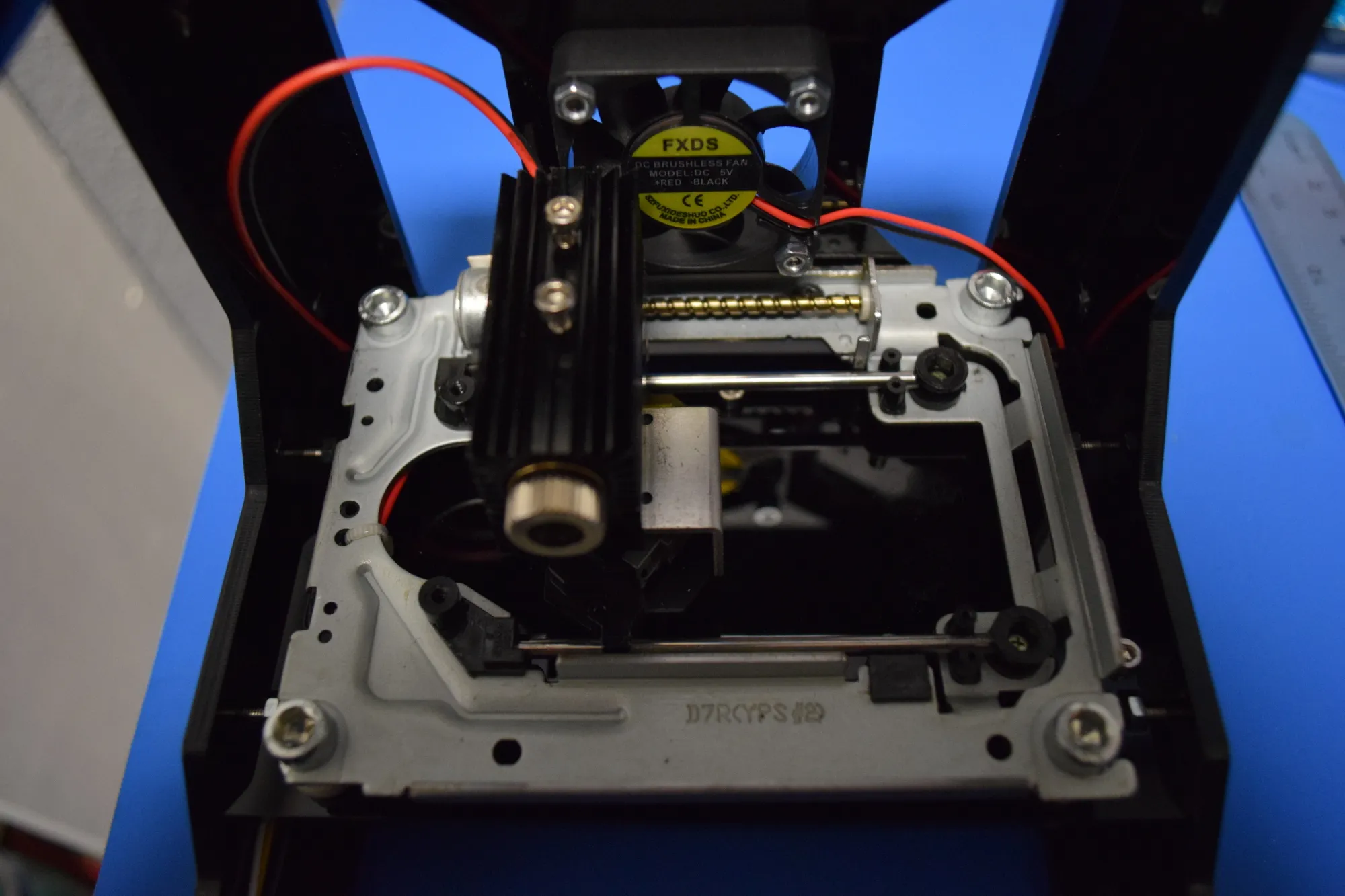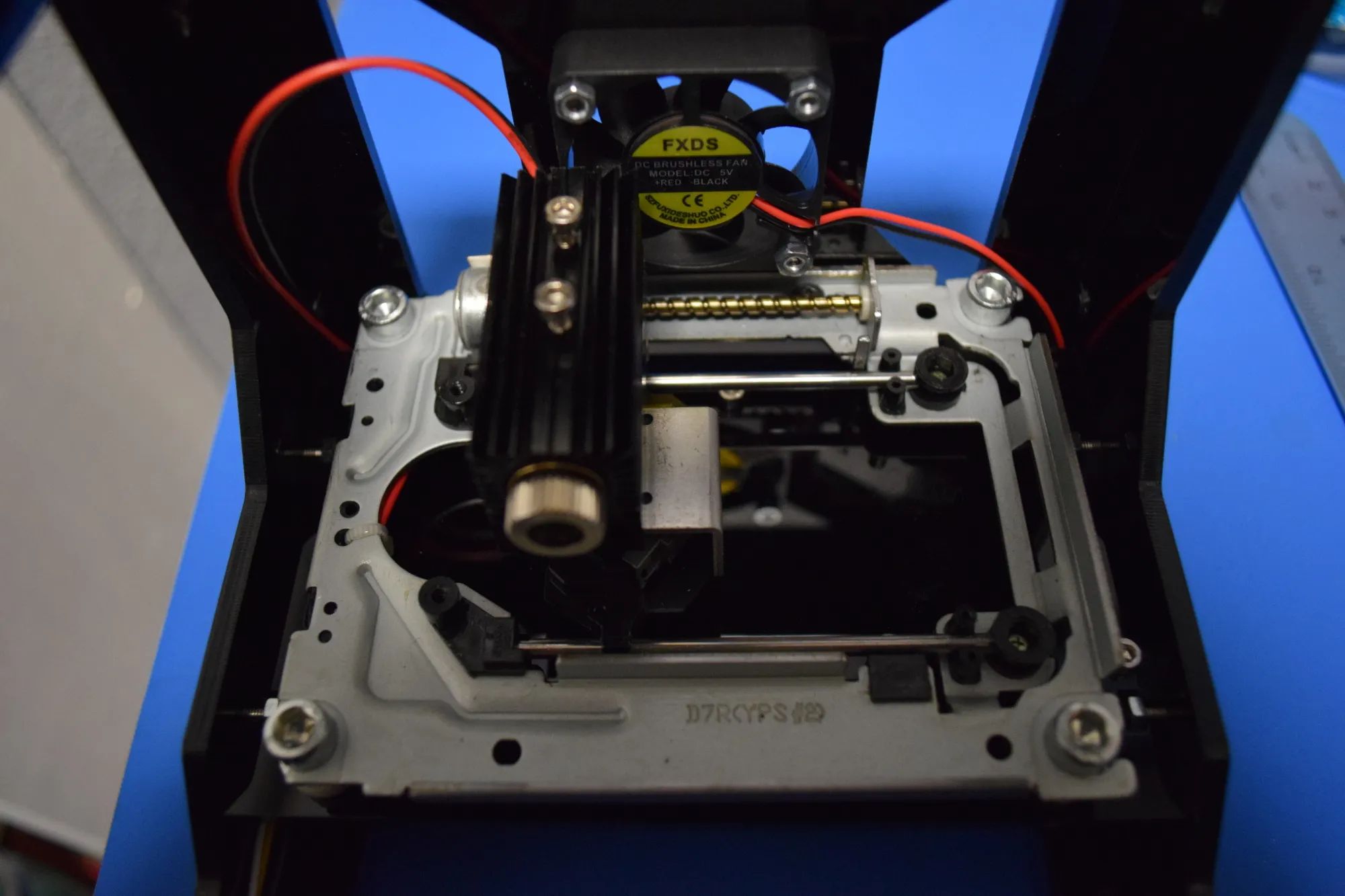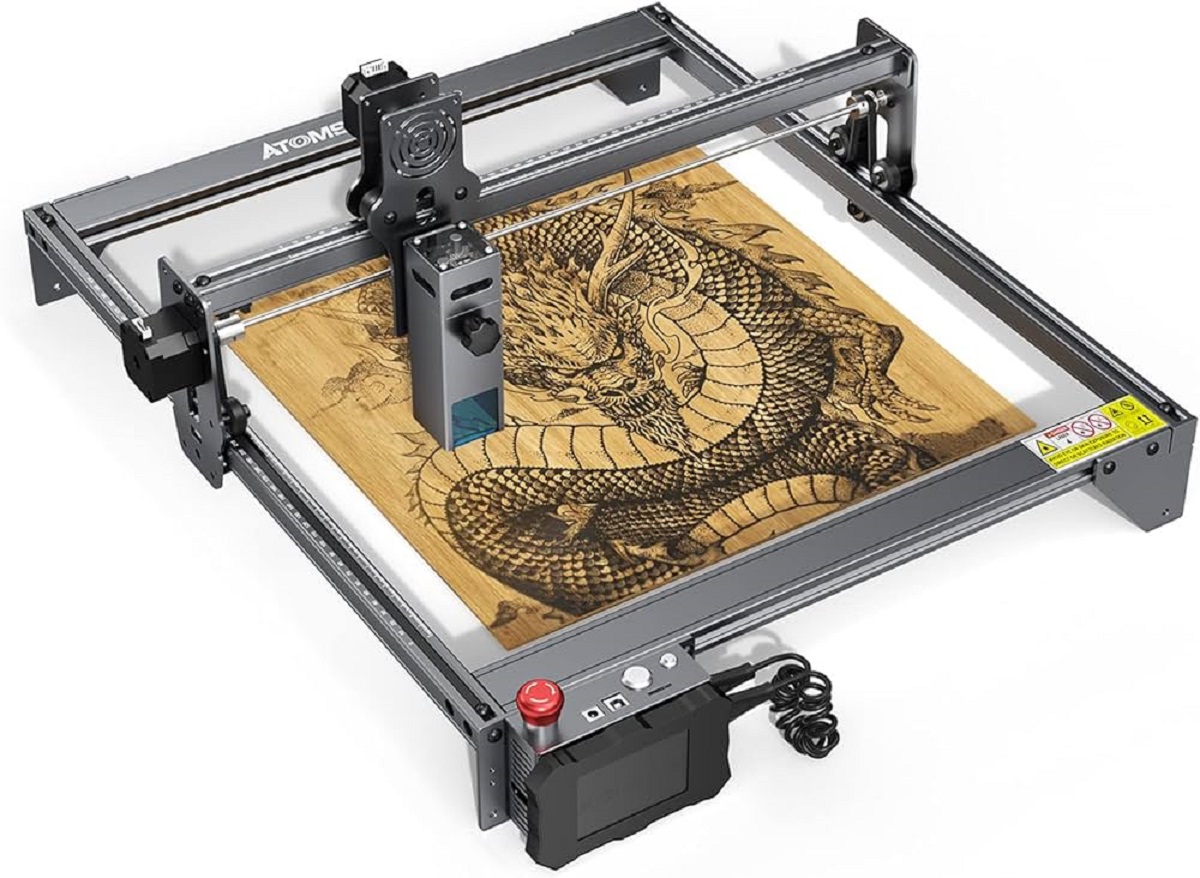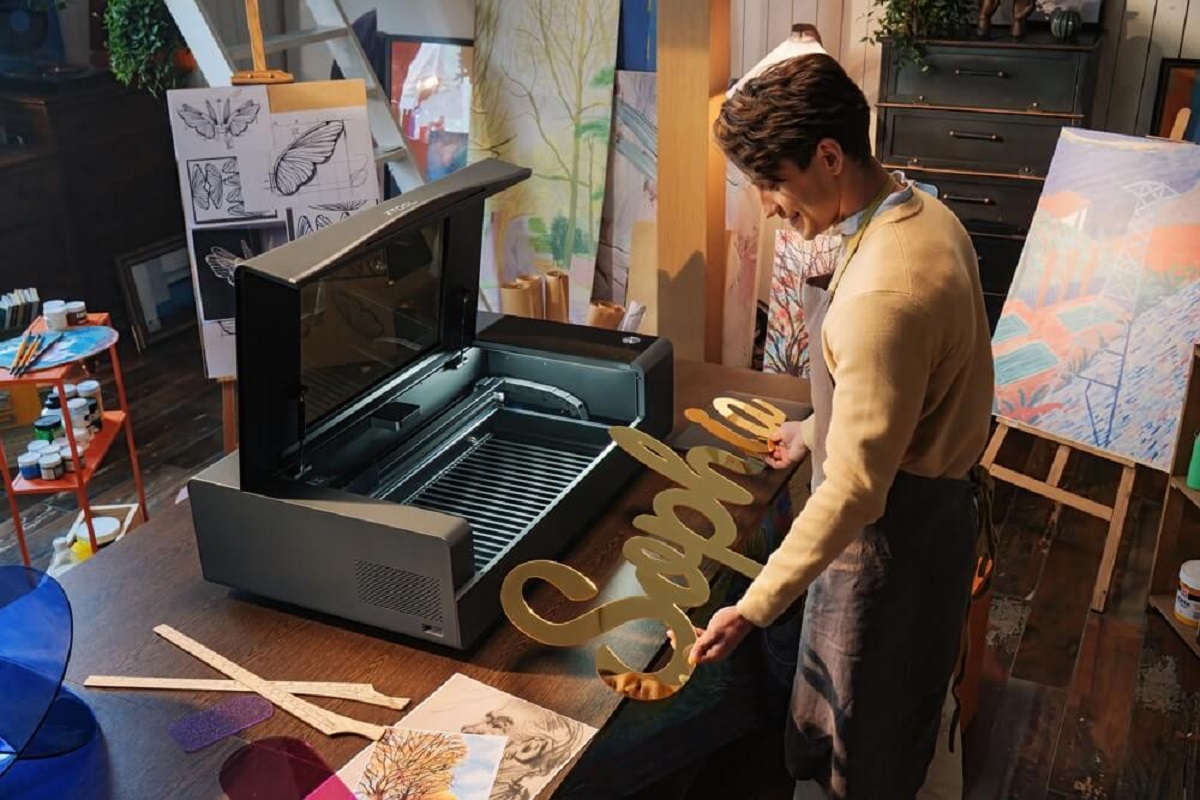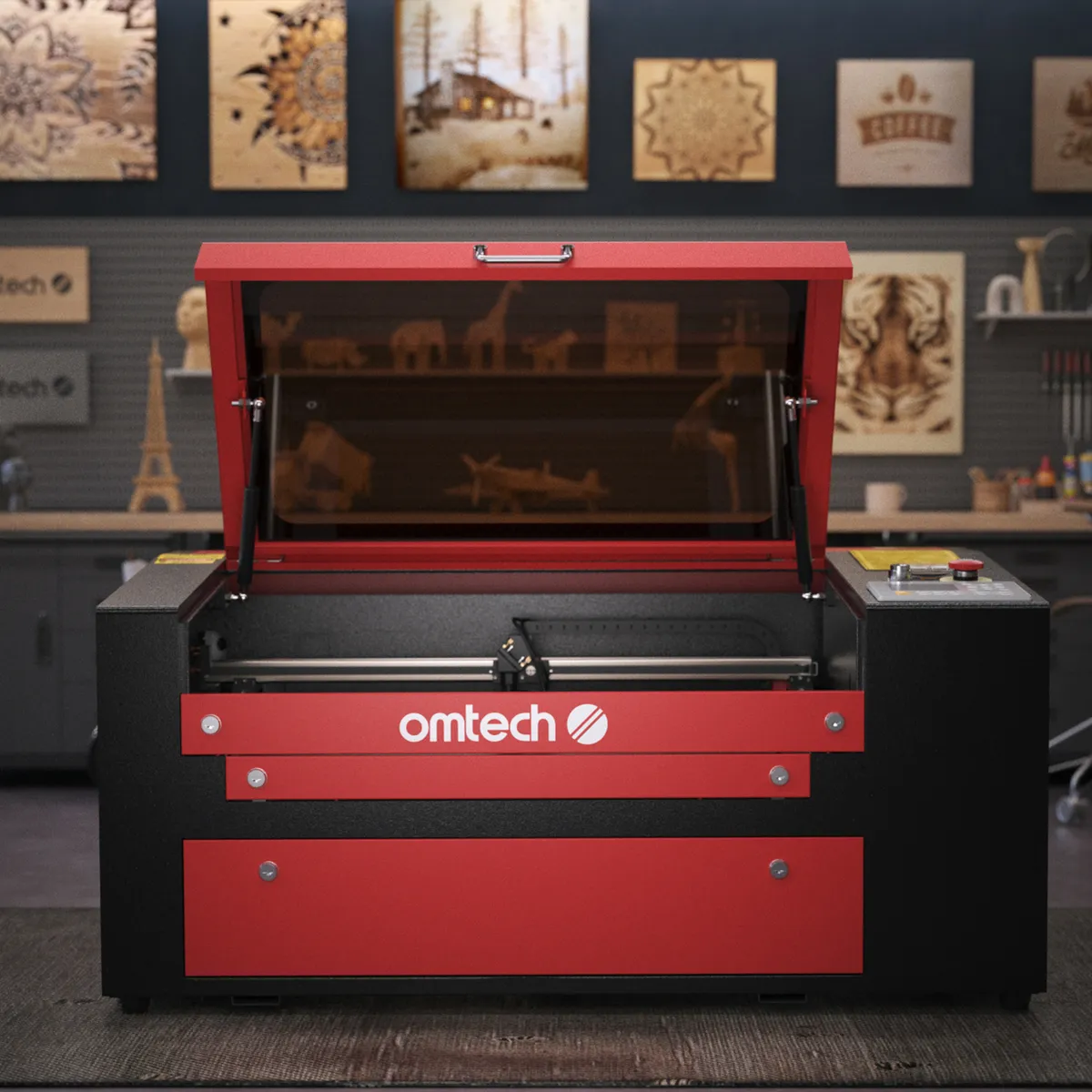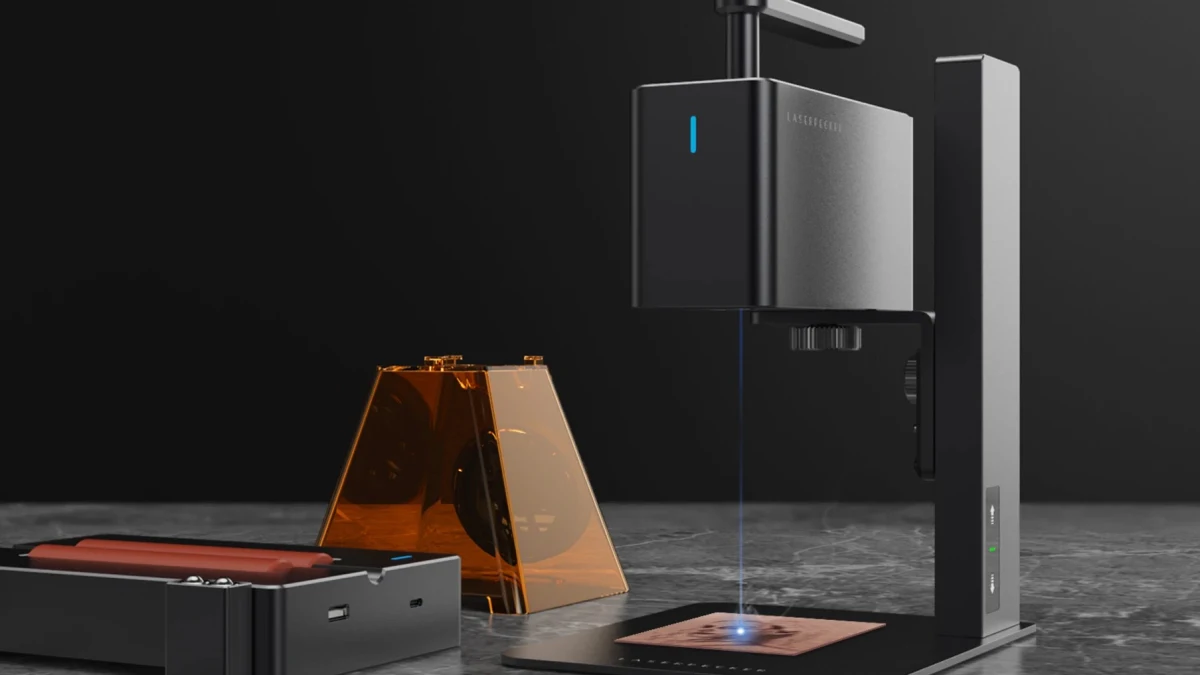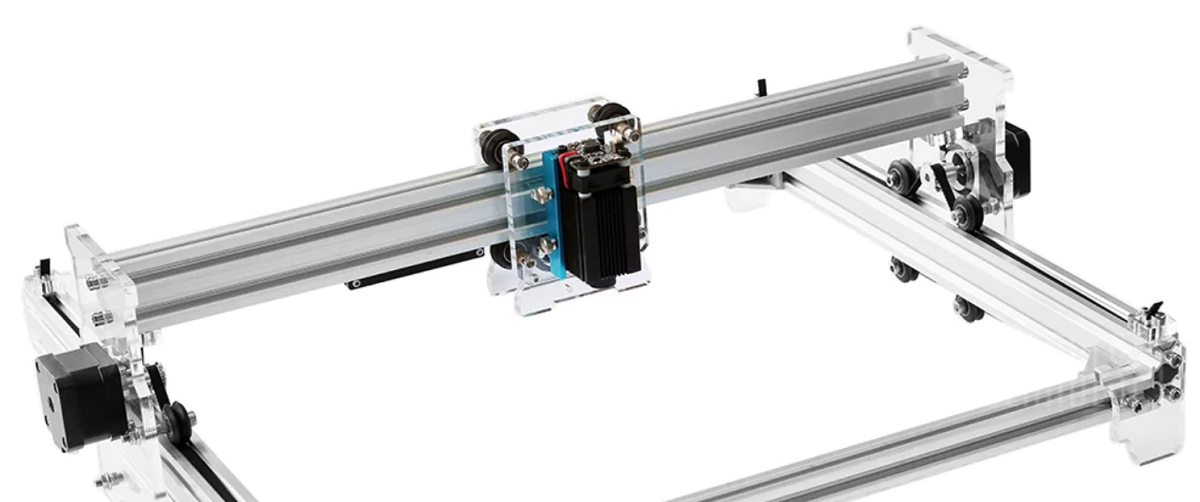Introduction
A 1000mW laser engraver is a powerful tool that utilizes laser technology to engrave various materials with precision and detail. Whether you are a hobbyist or a professional, a laser engraver allows you to add unique designs, personalized messages, or intricate patterns to a wide range of surfaces. From wood and acrylic to glass and metal, the possibilities are endless with a 1000mW laser engraver.
In this article, we will explore the capabilities, applications, benefits, and safety considerations of using a 1000mW laser engraver. Whether you are considering purchasing one for your own projects or simply curious about this fascinating technology, this guide aims to provide you with a comprehensive understanding of what a 1000mW laser engraver can do.
Before we dive into the details, let’s take a brief look at the basics. The term “1000mW” refers to the power output of the laser. The higher the wattage, the more powerful the laser, which typically corresponds to a deeper and faster engraving capability. This wattage range is considered mid-range, offering a balance between affordability and performance for most engraving needs.
Nowadays, laser engravers have become increasingly popular due to their versatility and ease of use. They have revolutionized various industries, including arts and crafts, signage, jewelry making, promotional products, and more. Let’s explore the fascinating world of laser engraving and discover how a 1000mW laser engraver can unlock endless creative possibilities.
What is a 1000mW Laser Engraver?
A 1000mW laser engraver is a device that utilizes a laser beam to engrave or mark various materials with precision. The “1000mW” refers to the power output of the laser, indicating its strength and capability.
With a power output of 1000mW, this type of laser engraver is considered to be in the mid-range, offering a good balance between affordability and performance. It provides enough power to engrave a variety of materials effectively, including wood, acrylic, leather, metal, glass, and more.
Laser engravers work by emitting a focused beam of light with high intensity. This beam interacts with the surface of the material, causing it to heat up and vaporize or melt, leaving behind a permanent mark or engraving. The precise control of the laser beam allows for intricate designs, detailed textures, and even photo engravings.
Most 1000mW laser engravers are desktop-sized, making them suitable for personal use, small businesses, or hobbyists. They are usually equipped with user-friendly software that enables you to create or import designs, adjust laser settings, and control the engraving process with ease.
The versatility of a 1000mW laser engraver makes it a valuable tool for a wide range of applications. Whether you are creating personalized gifts, adding branding to your products, making intricate jewelry designs, or creating custom signage, a 1000mW laser engraver can bring your ideas to life.
It is important to note that laser engravers require proper safety precautions due to the intensity of the laser beam. Protective eyewear, ventilation, and proper machine maintenance are essential to ensure safe operation.
In the next sections, we will explore the history and evolution of laser engravers, the applications of laser engraving, the benefits of using a 1000mW laser engraver, materials that can be engraved, tips and techniques for laser engraving, safety considerations, and troubleshooting common issues. By the end of this guide, you will have a comprehensive understanding of the capabilities and potential of a 1000mW laser engraver.
History and Evolution of Laser Engravers
The history of laser engravers traces back to the invention of lasers in the 1960s. Lasers, short for “Light Amplification by Stimulated Emission of Radiation,” revolutionized various industries with their focused and powerful beams of light.
The first laser engravers were large and expensive machines used primarily for industrial applications. They were mainly employed in the manufacturing industry for marking serial numbers, logos, and other identification codes on products.
As laser technology advanced and became more accessible, smaller and more affordable laser engravers were developed. This opened up opportunities for artists, hobbyists, and small businesses to explore the creative potential of laser engraving. Desktop-sized laser engravers became increasingly popular for their versatility, ease of use, and affordability.
The evolution of laser engravers also brought advancements in software and control systems. Initially, laser engravers relied on complicated and proprietary software. However, with the advancement of technology, user-friendly software interfaces were developed, making it easier for beginners to design and control the engraving process.
Today, laser engravers are equipped with powerful lasers, efficient cooling systems, and intuitive software interfaces. They can be connected to computers via USB or wireless connections, allowing for seamless integration with digital design software.
The affordability and availability of laser engravers have sparked a surge in creative applications across various industries. Artists use laser engraving to add intricate designs to their artwork, while businesses use it for branding and customizing their products. Laser-engraved gifts have also become popular among individuals looking for unique and personalized presents.
With the continued advancements in technology, laser engravers are expected to become even more powerful, efficient, and affordable. New materials and applications will continue to emerge, expanding the possibilities of laser engraving.
In the following sections, we will delve into the applications of laser engraving, the benefits of using a 1000mW laser engraver, the materials that can be engraved, tips and techniques for laser engraving, safety considerations, and troubleshooting common issues. By understanding the history and evolution of laser engravers, we gain a deeper appreciation for the capabilities and potential of these remarkable devices.
Applications of Laser Engraving
Laser engraving offers a wide range of applications across various industries, thanks to its precision, versatility, and ability to work on diverse materials. Let’s explore some of the common applications where laser engraving is widely used:
- Personalization: Laser engraving allows for the customization and personalization of various items. From engraving names and messages on jewelry, watches, and accessories to adding personalized designs to phone cases, laptops, and keychains, laser engraving adds a personal touch to gifts and everyday items.
- Art and Crafts: Artists and craftsmen use laser engraving to create intricate designs, patterns, and textures on various materials. Wood, leather, acrylic, and even fabric can be transformed into unique art pieces through laser engraving. The precise control of the laser beam allows for detailed etching and shading, giving artists endless creativity.
- Trophies and Awards: Laser engraving is commonly used in the production of trophies, plaques, and awards. Names, logos, and achievements can be elegantly engraved onto materials such as glass, crystal, acrylic, and metal, adding a touch of sophistication to recognition pieces.
- Signage and Branding: Laser engraving is widely utilized for creating custom signs and branding materials. It offers the ability to engrave logos, text, and graphics onto materials like wood, acrylic, and metal. The precision and durability of laser engraving ensure that signs and branding materials have a professional and lasting appearance.
- Jewelry and Accessories: Laser engraving plays an important role in the jewelry industry. It enables the engraving of detailed designs, initials, dates, and special messages on rings, pendants, bracelets, and other jewelry pieces. Laser engraving on metals such as gold, silver, titanium, and stainless steel adds a personalized touch to fine jewelry.
- Industrial Applications: Laser engraving finds its place in various industrial applications. From marking serial numbers and barcodes on manufactured products to engraving identification codes on electronic components, laser engraving offers a permanent and precise marking solution.
These are just a few examples of the many applications where laser engraving excels. The versatility and precision of laser engraving make it a valuable tool for artists, craftsmen, businesses, and individuals looking to add a touch of personalization or professionalism to their projects.
In the next sections, we will explore the benefits of using a 1000mW laser engraver, the materials that can be engraved, tips and techniques for laser engraving, safety considerations, and troubleshooting common issues. By understanding the breadth of applications for laser engraving, you can unlock the full potential of a 1000mW laser engraver for your projects and creativity.
Benefits of Using a 1000mW Laser Engraver
Using a 1000mW laser engraver offers numerous benefits for individuals, businesses, and artisans. Let’s explore some of the key advantages:
- Precision: A 1000mW laser engraver provides precise engraving capabilities. The focused laser beam allows for intricate detailing, fine lines, and smooth curves, resulting in high-quality and professional-looking engravings.
- Versatility: A 1000mW laser engraver can work with various materials, including wood, acrylic, leather, glass, metal, and more. This versatility allows you to explore a wide range of projects and applications.
- Speed: With a 1000mW power output, laser engraving can be done quickly and efficiently. The fast engraving speed reduces production time, making it suitable for both small-scale and large-scale projects.
- Customization: Laser engraving offers endless customization possibilities. Whether it’s engraving personal messages on gifts, adding logos to promotional items, or creating unique designs on jewelry, a 1000mW laser engraver allows you to bring your creative ideas to life.
- Durability: Engravings done with a laser are highly durable. The laser creates permanent marks that resist fading, scratching, and wear over time. This makes laser-engraved items long-lasting and suitable for both indoor and outdoor use.
- Efficiency: Using a 1000mW laser engraver is efficient in terms of both time and energy. Compared to traditional engraving methods, laser engraving requires minimal setup, reduces material waste, and requires no additional tools such as cutting bits or stamps.
- Automation: Many 1000mW laser engravers come with advanced software that enables automation and precise control over the engraving process. This means you can easily repeat designs, adjust settings, and produce consistent results without the need for manual intervention.
- Clean and Contactless: Laser engraving is a clean and contactless process. Unlike traditional engraving methods that involve physical contact with the material, laser engraving eliminates the risk of damage or distortion caused by tooling or pressure.
- Wide Range of Applications: From personalized gifts to industrial marking, a 1000mW laser engraver can be used across various industries and creative projects. The versatility and precision of laser engraving make it a valuable tool for artisans, businesses, and hobbyists alike.
Using a 1000mW laser engraver provides efficiency, precision, versatility, and endless creative possibilities. Whether you are looking to start a business, enhance your artistic projects, or simply enjoy the satisfaction of creating personalized items, a 1000mW laser engraver is a valuable investment.
In the next sections, we will explore the materials that can be engraved with a 1000mW laser engraver, tips and techniques for laser engraving, safety considerations, and troubleshooting common issues. These insights will further enhance your understanding of how to maximize the benefits of using a 1000mW laser engraver.
Materials You Can Engrave with a 1000mW Laser Engraver
A 1000mW laser engraver offers the versatility to engrave a wide range of materials. The power and precision of the laser beam make it possible to achieve detailed and stunning engravings on various surfaces. Here are some of the materials that you can engrave using a 1000mW laser engraver:
- Wood: Whether it’s hardwood, plywood, or veneer, wood is an excellent material for laser engraving. From intricate designs on furniture and decorative items to personalized wooden signs and gifts, a 1000mW laser engraver can create beautiful and precise engravings on wood.
- Acrylic: Acrylic is a popular choice for laser engraving due to its transparency and versatility. It can be used to create signage, keychains, display stands, and various other decorative items. With a 1000mW laser engraver, you can achieve clean and detailed engravings on acrylic surfaces.
- Leather: Leather engraving adds a touch of elegance and personalization to bags, wallets, journals, and other leather products. A 1000mW laser engraver can engrave intricate patterns, text, and even photographs onto leather surfaces, creating unique and custom-made items.
- Glass: Glass engraving offers a sophisticated and classy look to awards, trophies, drinkware, and decorative items. With a 1000mW laser engraver, you can etch designs, names, and logos onto glass surfaces, creating beautiful and personalized pieces.
- Metal: While metals require a higher power output to engrave deeply, a 1000mW laser engraver can still produce surface engravings on metal materials such as aluminum, stainless steel, brass, and copper. This is ideal for creating personalized jewelry, tags, and small decorative items.
- Stone: Natural stones like marble, granite, and slate can also be engraved using a 1000mW laser engraver. These engravings are particularly popular for creating personalized plaques, coasters, and home decor items.
- Plastic: Plastics like ABS, PVC, and polycarbonate are common materials for laser engraving. They are widely used in the production of signage, tags, labels, and promotional items.
- Paper and Cardboard: Laser engraving can add intricate designs and patterns to paper and cardboard materials. This is especially useful for creating unique stationery, cards, packaging, and decorative items.
These are just a few examples of the materials that can be engraved with a 1000mW laser engraver. It’s important to note that each material may require different laser settings, so it’s advisable to test and experiment with different parameters to achieve the desired results.
In the next sections, we will explore tips and techniques for laser engraving with a 1000mW laser engraver, safety considerations, and troubleshooting common issues. These insights will further enhance your knowledge and skills in laser engraving, allowing you to unlock the full potential of your 1000mW laser engraver.
Tips and Techniques for Laser Engraving with a 1000mW Laser Engraver
Laser engraving with a 1000mW laser engraver requires a combination of technical know-how and creativity. Here are some tips and techniques to help you achieve the best results:
- Prepare Your Material: Ensure that the material you are engraving is clean and free from dust or debris. This will help achieve a crisp and clean engraving.
- Test Your Settings: Before engraving your final piece, always conduct a test engraving on a similar or scrap material. This will allow you to optimize your laser settings for the best results, such as adjusting the power, speed, and frequency settings.
- Focus Adjustment: Proper focus is crucial for achieving sharp and accurate engravings. Ensure that the laser beam is focused correctly on the surface of your material. Refer to your machine’s manual for instructions on how to adjust the focus properly.
- Design Considerations: When creating designs for laser engraving, consider the size, complexity, and level of detail. Intricate designs may require slower engraving speeds and higher power settings, while larger designs may benefit from faster speeds and lower power settings.
- Vector and Raster Engraving: Most laser engraving software supports both vector and raster engraving. Use vector mode for cutting or scoring lines, and raster mode for shading, gradients, and complex designs. It’s important to understand the difference and choose the appropriate mode.
- Proper Ventilation: Laser engraving produces fumes and smoke, especially when engraving certain materials. Ensure that your workspace is well-ventilated to remove any harmful substances and keep the air quality safe.
- Masking Tape or Spray: To minimize smoke residue or prevent marks on certain materials, you can apply masking tape or use spray-on products specifically designed for laser engraving. These protective measures can help create clean and professional results.
- Engraving Speed: Experiment with different engraving speeds to find the optimal balance between speed and quality. Increasing the speed may result in a lighter engraving, while reducing the speed will produce a darker and deeper mark. Adjust the speed according to your desired effect.
- Proper Alignment: When engraving multiple pieces or using different laser settings, make sure your material is properly aligned on the engraving bed. Use alignment guides or marks to ensure consistent positioning and avoid misalignment.
- Clean and Maintain Your Machine: Regularly clean your laser engraver and inspect the lenses and mirrors for any dirt or debris that may affect the engraving quality. Follow the manufacturer’s recommendations for maintenance to ensure optimal performance.
By following these tips and techniques, you can enhance your laser engraving skills and achieve impressive results with your 1000mW laser engraver. Experiment, practice, and let your creativity flourish to unlock the full potential of this versatile tool.
In the following sections, we will explore safety considerations for using a 1000mW laser engraver, troubleshooting common issues, and additional resources to further enhance your laser engraving knowledge.
Safety Considerations for Using a 1000mW Laser Engraver
While using a 1000mW laser engraver can be exciting and rewarding, it is important to prioritize safety. Here are some key safety considerations to keep in mind when using a 1000mW laser engraver:
- Protective Eyewear: Always wear appropriate laser safety goggles or glasses designed for the specific wavelength of the laser used in your engraver. This protects your eyes from potential laser radiation and prevents accidental exposure.
- Ventilation: Ensure that your workspace has adequate ventilation to dissipate any fumes or smoke generated during the engraving process. This will help maintain good air quality and prevent the inhalation of harmful substances.
- Machine Location: Place your laser engraver in a location that minimizes the risk of accidental contact or exposure. Keep it away from flammable materials, children, and pets, and ensure that it is on a stable surface to prevent it from falling or being knocked over.
- Machine Maintenance: Regularly inspect and clean your laser engraver to ensure optimal performance and safety. Follow the manufacturer’s guidelines for maintenance and address any issues or repairs promptly.
- Fire Safety: Have a fire extinguisher readily available in your workspace, and be familiar with how to use it properly. Laser engraving can generate heat and potentially ignite flammable materials, so it’s important to have safety measures in place.
- Material Compatibility: Check the compatibility of the materials you are engraving with the laser settings. Some materials may emit toxic fumes or produce hazardous particles when engraved. Research and understand the safety precautions for each material before engraving.
- Operator Training: Ensure that anyone operating the laser engraver has received proper training and understands the safety protocols. Familiarize yourself with the user manual, software, and control settings to operate the machine confidently and safely.
- Emergency Procedures: Be familiar with the emergency shutdown procedures for your laser engraver. In the event of any accidents or malfunctions, knowing how to quickly stop the machine can prevent further damage or harm.
- Personal Protective Equipment (PPE): In addition to protective eyewear, consider wearing appropriate clothing, gloves, and closed-toe shoes to protect yourself from potential flying debris or accidental contact with the laser beam.
- Responsible Operation: Always supervise the laser engraving process and avoid leaving the machine unattended while it is in use. This helps prevent any potential accidents and allows you to address any issues that may arise immediately.
By following these safety considerations, you can ensure a safer and more enjoyable experience while using your 1000mW laser engraver. Prioritize your well-being and take the necessary precautions to create a secure work environment.
In the next sections, we will discuss troubleshooting common issues that may arise with a 1000mW laser engraver and provide additional resources to further enhance your laser engraving knowledge.
Troubleshooting Common Issues with a 1000mW Laser Engraver
While working with a 1000mW laser engraver, you may encounter certain common issues that can affect the quality of your engravings. It’s important to understand these issues and learn how to troubleshoot them. Here are some common problems and their possible solutions:
- Inconsistent Engravings: If you notice inconsistent engraving depths or uneven lines, it may be due to improper focus or material alignment. Check that your material is properly aligned and adjust the focus of your laser beam as needed. Also, ensure that the surface of the material is flat and level before engraving.
- Burning or Charring: Excessive burning or charring can occur when the laser power is too high or the engraving speed is too slow. Try adjusting the power and speed settings to find the right balance for your specific material. Additionally, ensure that your material is properly prepared, and you have good ventilation in your workspace.
- Light or Faint Engravings: Light or faint engravings may be caused by low laser power or high engraving speed. Increase the power and adjust the speed settings accordingly to achieve darker and more defined engravings. However, be cautious not to set the power too high, as it may lead to excessive burning or melting of the material.
- Smoke Residue: If you notice excessive smoke residue on your engravings, it may be due to improper ventilation in your workspace. Ensure that you have proper ventilation to remove the smoke and fumes generated during the engraving process. You can also consider using masking tape or laser-specific engraving sprays to minimize smoke residue.
- Engraving Alignment: If you’re working on multiple pieces or if your engraving is not aligned correctly, it may be due to improper material placement on the engraving bed. Double-check your material alignment, use alignment guides or marks, and ensure that the material is securely fixed in place for accurate engraving.
- Software or Connection Issues: If you’re experiencing issues with your laser engraver’s software or connection, ensure that you have the latest software version installed. Verify the USB connection and try reconnecting or restarting both the machine and your computer. If the problem persists, consult the manufacturer’s troubleshooting guide or reach out to technical support.
- Excessive Engraving Time: If your engravings are taking longer than expected, it may be due to a slow engraving speed or a low-power setting. Adjust the speed and power settings accordingly to optimize the engraving time. However, ensure that the adjustments do not compromise the quality of the engravings.
- Machine Maintenance: Regularly clean and maintain your laser engraver to prevent issues. Check the lenses, mirrors, and other components for any dirt, residue, or damage. Follow the manufacturer’s guidelines for maintenance and address any necessary repairs promptly.
Remember, troubleshooting can vary depending on your specific laser engraver model and the materials you are working with. It’s always beneficial to consult the manufacturer’s manual, online forums, or seek assistance from the manufacturer’s technical support team for specific troubleshooting advice.
In addition to troubleshooting, continuous practice, experimentation, and learning from your experiences will help you become more proficient in using your 1000mW laser engraver. Stay patient, embrace the challenges, and don’t hesitate to seek help when needed.
In the final section, we will conclude with a summary and additional resources to further enhance your laser engraving knowledge and skills.
Conclusion
Using a 1000mW laser engraver opens up a world of creative possibilities. The precision, versatility, and power of this tool allow you to engrave a wide range of materials with impeccable detail and clarity. From personalized gifts and decorative items to industrial applications and branding materials, the applications for laser engraving are vast and ever-expanding.
In this guide, we explored the various aspects of using a 1000mW laser engraver. We learned about its history and evolution, the applications it serves across different industries, and the benefits it offers in terms of precision, customization, and efficiency. We also discussed the materials that can be engraved, provided tips and techniques for successful engraving, and highlighted the importance of safety precautions and troubleshooting common issues.
As you embark on your laser engraving journey, remember to prioritize safety, follow the manufacturer’s guidelines, and practice proper maintenance. Be open to experimentation, learn from your experiences, and embrace the opportunities for creativity that a 1000mW laser engraver presents.
To enhance your skills further, there are numerous resources available online, including tutorial videos, user communities, and forums, where you can find helpful tips and inspiration from fellow laser engraving enthusiasts. Stay curious, continue exploring new techniques, and keep refining your craft.
Whether you are a hobbyist, artist, or business owner, a 1000mW laser engraver can elevate your projects and bring your visions to life. Embrace the power of laser engraving, and let your imagination guide you to create remarkable and personalized pieces.
Thank you for joining us on this journey into the world of laser engraving with a 1000mW laser engraver.









